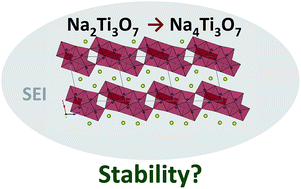Taking steps forward in understanding the electrochemical behavior of Na2Ti3O7†
Abstract
Na2Ti3O7 is an interesting negative electrode material for sodium ion batteries given its electrochemical capacity and low operation potential. Unfortunately its prospects of practical application are hindered by an unacceptable capacity fading upon cycling. In this work we combine experiments and DFT calculations to investigate the origin of such a phenomenon. Different electrode technologies and different electrolytes have been targeted for electrochemical testing while the stability of Na2Ti3O7 and the fully reduced Na4Ti3O7 has been studied. The calculated elastic constants and vibrational modes support the mechanical and dynamical stability of the Na4Ti3O7 structure. In situ XRD measurements corroborate the reversibility of the insertion reaction as no structural damage is detected after 50 cycles. An intriguing reactivity of Na2Ti3O7 with the electrolyte upon storage is observed, which coupled to electrochemical measurements points to this being the main factor behind capacity fading.


 Please wait while we load your content...
Please wait while we load your content...